African mangosteen
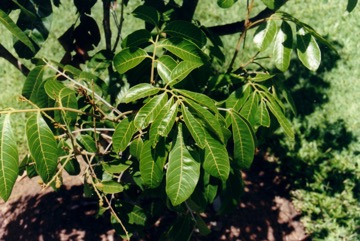
It is a tropical plant. It grows in the hot dry tropical lowlands. Trees grow best on acid soils. They have good salt tolerance. The leaves are wind resistant. Established trees are drought resistant but for best fruit production regular watering is needed. Trees are cold hardy. Trees can survive temperatures down to -3°C. Trees grow best with plenty of sunlight. They grow naturally in open woodland often under the shelter of larger trees. It grows in Miombo woodland. In Zimbabwe it grows up to 1,050 m above sea level. It does best with a pH of 5.5-7. It can grow in arid places. It suits hardiness zones 9-12. In Cairns BG.
Also known as:
Chedi, Chimbango, Etunganan, Himbi, Imbe, Impembe, Isinpula, Isinyula, Kikangakanywa, Kisambwe, Laeveldse geelmelkhout, Lisimpula, Livingstone garcinia, Lowveld mangosteen, Mbigo, Mgidzofidzo, Mfungatanzu, Mndee-mzize, Motsaodi, Motsaudi, Mpekecho, Mphimbi, Mpugopugo, Mtotozi, Muelece, Mukanga, Mufodzohi, Mukwananga, Mujanuo, Munhinzwa, Muphiphi, Mupimbi, Murongwe, Mutumbi, Mutungwa, Ngangakanywa, Pohon manggis afrika, Senyula, Shamper, Shanfarood, Sina, Sinyula, Tulla, Umpimbo, Ushika
Synonyms
- Garcinia angolensis Vesque
- Garcinia baikieana Vesque
- Garcinia ferrandii Chiov.
Edible Portion
- Fruit, Leaves, Gum
Where does African mangosteen grow?
Found in: Africa, Asia, Australia, Angola, Botswana, Brazil, Burkina Faso, Cameroon, Central Africa, Central America, Congo, Côte d'Ivoire, Cuba, East Africa, Eswatini, Ethiopia, Ghana, Guinea, Guinée, Guinea-Bissau, India, Indonesia, Ivory Coast, Jamaica, Kenya, Malawi, Mali, Mozambique, Namibia, Nigeria, North America, SE Asia, Senegal, Somalia, South Africa, Southern Africa, South America, Sudan, Swaziland, Tanzania, Togo, Uganda, United States, West Africa, West Indies, Zambia, Zimbabwe
Notes: The leaves and flowers have proven antibiotic activity. The fruit leave lasting stains. There are about 300 Garcinia species.
Status: It is an attractive fruit. It is a cultivated food plant. It is a commonly used fruit in Mozambique.
Growing African mangosteen
Cultivation: As male and female flowers occur on separate trees both male and female trees must be planted. A male tree can be grafted onto a female. Trees can be grown from seed but these take 5-6 years to reach fruiting age. Earlier fruiting can be achieved by grafting onto established rootstocks. Zinc deficiency is more common on alkaline soils. Trees can be grown by air-layering.
Edible Uses: The fruit can be eaten fresh. They are also cooked with porridge. They are also used in ice cream, jam and drinks. They are used to make an alcoholic drink. It develops a purple colour. Caution: Alcohol is a cause of cancer.
Production: Trees grow slowly. Seedling trees can take 5-6 years until fruiting. Grafted trees can fruit in 3 years. The fruit take 28 days until ripe after fruit set. Fruit are harvested when fully ripe and do not store well.
Nutrition Info
per 100g edible portion| Edible Part | Energy (kcal) | Protein (g) | Iron (mg) | Vitamin A (ug) | Vitamin c (mg) | Zinc (mg) | % Water |
|---|---|---|---|---|---|---|---|
| Fruit | 61 | 0.8 | 0.3 | - | 5.4 | 0.2 | 83 |
African mangosteen Photos

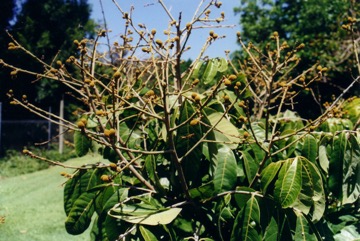
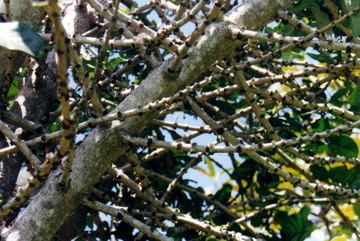
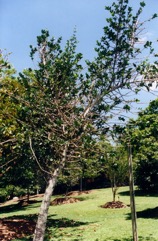
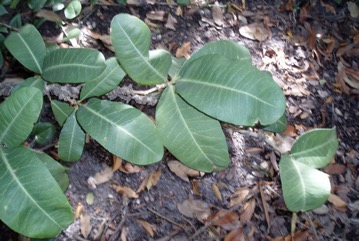
References
Addis, G., et al, 2013, The Role of Wild and Semi-wild Edible Plants in Household Food Sovereignty in Hamer and Konso Communities, South Ethiopia. Ethnobotany Research & Applications. 11:251-271
Ambasta, S.P. (Ed.), 2000, The Useful Plants of India. CSIR India. p 230
Asfaw, Z. and Tadesse, M., 2001, Prospects for Sustainable Use and Development of Wild Food Plants in Ethiopia. Economic Botany, Vol. 55, No. 1, pp. 47-62
Awodoyin, R.O., Olubode, O.S., Ogbu, J.U., Balogun, R.B., Nwawuisi, J.U. and Orji, K.O., 2015, Indigenous Fruit Trees of Tropical Africa: Status, Opportunity for Development and Biodiversity Management. Agricultural Sciences, 6, 31-41
Barwick, M., 2004, Tropical and Subtropical Trees. A Worldwide Encyclopedic Guide. Thames and Hudson p 195
Burkill, H. M., 1985, The useful plants of west tropical Africa, Vol. 2. Kew.
Burkill, I.H., 1966, A Dictionary of the Economic Products of the Malay Peninsula. Ministry of Agriculture and Cooperatives, Kuala Lumpur, Malaysia. Vol 1 (A-H) p 1069
Cundall, P., (ed.), 2004, Gardening Australia: flora: the gardener's bible. ABC Books. p 624
Dale, I. R. and Greenway, P. J., 1961, Kenya Trees and Shrubs. Nairobi. p 231
Darley, J.J., 1993, Know and Enjoy Tropical Fruit. P & S Publishers. p 45
Etherington, K., & Imwold, D., (Eds), 2001, Botanica's Trees & Shrubs. The illustrated A-Z of over 8500 trees and shrubs. Random House, Australia. p 338
Facciola, S., 1998, Cornucopia 2: a Source Book of Edible Plants. Kampong Publications, p 79
FAO, 1988, Traditional Food Plants, FAO Food and Nutrition Paper 42. FAO Rome p 298
Fowler, D. G., 2007, Zambian Plants: Their Vernacular Names and Uses. Kew. p 18
Fox, F. W. & Young, M. E. N., 1982, Food from the Veld. Delta Books. p 155
Goode, P., 1989, Edible Plants of Uganda. FAO p 30
Grivetti, L. E., 1980, Agricultural development: present and potential role of edible wild plants. Part 2: Sub-Saharan Africa, Report to the Department of State Agency for International Development. p 44, 47, 72
Hedrick, U.P., 1919, (Ed.), Sturtevant's edible plants of the world. p 324
INFOODS:FAO/INFOODS Databases
Jardin, C., 1970, List of Foods Used In Africa, FAO Nutrition Information Document Series No 2.p 139
J. Linn. Soc., Bot. 9:263. 1867
John, L., & Stevenson, V., 1979, The Complete Book of Fruit. Angus & Robertson p 187
Johns, T., Mhoro, E. B. and Sanaya, P., 1996, Food Plants and Masticants of the Batemi of Ngorongoro District, Tanzania. Economic Botany, Vol. 50, No. 1, pp. 115-121
Keay, R.W.J., 1989, Trees of Nigeria. Clarendon Press, Oxford. p 108
Kidane, B., et al, 2014, Ethnobotany of Wild and Semi-wild Edible Fruit Species used by Maale and Ari Ethnic Communities in South Ethiopia. Ethnobotany Research and Applications. Vol. 12, 1546-3465-12-455
Kiple, K.F. & Ornelas, K.C., (eds), 2000, The Cambridge World History of Food. CUP p 1789
Long, C., 2005, Swaziland's Flora - siSwati names and Uses http://www.sntc.org.sz/flora/
Lorenzi, H., Bacher, L., Lacerda, M. & Sartori, S., 2006, Brazilian Fruits & Cultivated Exotics. Sao Paulo, Instituto Plantarum de Estuados da Flora Ltda. p 377
Lovett, J. C. et al, Field Guide to the Moist Forest Trees of Tanzania. p 66
Lulekal, E., et al, 2011, Wild edible plants in Ethiopia: a review on their potential to combat food insecurity. Afrika Focus - Vol. 24, No 2. pp 71-121
Lyle, S., 2006, Discovering fruit and nuts. Land Links. p 218
Magwede, K., van Wyk, B.-E., & van Wyk, A. E., 2019, An inventory of Vhavenḓa useful plants. South African Journal of Botany 122 (2019) 57–89
Mannheimer, C. A. & Curtis. B.A. (eds), 2009, Le Roux and Muller's Field Guide to the Trees and Shrubs of Namibia. Windhoek: Macmillan Education Namibia. p 344
Martin, F. W., et al, 1987, Perennial Edible Fruits of the Tropics. USDA Handbook 642 p 29
Maundu, P. et al, 1999, Traditional Food Plants of Kenya. National Museum of Kenya. 288p
Mausse, S. D. & Bandeira, R. R., 2007, Ecological relationships between Ceratitis spp. (Diptera: Tephritidae) and other native fruit tree pests in southern Mozambique. Fruits, 2007, vol. 62, p 35-44
Mbuya, L.P., Msanga, H.P., Ruffo, C.K., Birnie, A & Tengnas, B., 1994, Useful Trees and Shrubs for Tanzania. Regional Soil Conservation Unit. Technical Handbook No 6. p 280
Mutie, F. G., 2020, Conservation of Wild Food Plants and Their Potential for Combatting Food Insecurity in Kenya as Exemplified by the Drylands of Kitui County. Plants 2020, 9, 1017
Neelo, J., et al, 2015, Ethnobotanical Survey of Woody Plants in Shorobe and Xobe Villages, Northwest Region of Botswana. Ethnobotany Research & Applications 14:367-379
Neudeck, L. et al, 2012, The Contribution of Edible Wild Plants to Food Security, Dietary Diversity and Income of Households in Shorobe Village, Northern Botswana. Ethnobotany Research & Applications 10:449-462
Njana, M. A., et al, 2013, Are miombo woodlands vital to livelihoods of rural households? Evidence from Urumwa and surrounding communities, Tabora, Tanzania. Forests, Trees and Livelihoods, 22:2, 124-140
Pakia, M., 2000, Plant Ecology and Ethnobotany of two sacred forests (Kayas) at the Kenya Coast. M. Sc. Thesis.
Palgrave, K.C., 1996, Trees of Southern Africa. Struik Publishers. p 614
Palmer, E and Pitman, N., 1972, Trees of Southern Africa. Vol. 3. A.A. Balkema, Cape Town p 1515
Peters, C. R., O'Brien, E. M., and Drummond, R.B., 1992, Edible Wild plants of Sub-saharan Africa. Kew. p 84
Plowes, N. J. & Taylor, F. W., 1997, The Processing of Indigenous Fruits and other Wildfoods of Southern Africa. in Smartt, L. & Haq. (Eds) Domestication, Production and Utilization of New Crops. ICUC p 191
Purseglove, J.W., 1968, Tropical Crops Dicotyledons, Longmans. p 634
Roodt, V., 1998, Trees & Shrubs of the Okavango Delta. Medicinal Uses and Nutritional value. The Shell Field Guide Series: Part 1. Shell Botswana. p 111
Royal Botanic Gardens, Kew (1999). Survey of Economic Plants for Arid and Semi-Arid Lands (SEPASAL) database. Published on the Internet; http://www.rbgkew.org.uk/ceb/sepasal/internet [Accessed 16th April 2011]
Ruffo, C. K., Birnie, A. & Tengnas, B., 2002, Edible Wild Plants of Tanzania. RELMA p 342
Ruiters-Welcome, A. K., 2019, Food plants of southern Africa. Ph.D. thesis. Univ. of Johannesburg p 44
Schmidt, E., Lotter, M., & McCleland, W., 2007, Trees and shrubs of Mpumalanga and Kruger National Park. Jacana Media p 424
Seyoum, Y., et al, 2015, Edible Wild Fruit Trees and Shrubs and Their Socioeconomic Significance in Central Ethiopia. Ethnobotany Research & Applications. 14:183-197
Sukarya, D. G., (Ed.) 2013, 3,500 Plant Species of the Botanic Gardens of Indonesia. LIPI p 300
Swaziland's Flora Database http://www.sntc.org.sz/flora
Tankard, G., 1990, Tropical fruit. An Australian Guide to Growing and using exotic fruit. Viking p 108
Tredgold, M.H., 1986, Food Plants of Zimbabwe. Mambo Press. p 103
USDA, ARS, National Genetic Resources Program. Germplasm Resources Information Network - (GRIN). [Online Database] National Germplasm Resources Laboratory, Beltsville, Maryland. Available: www.ars-grin.gov/cgi-bin/npgs/html/econ.pl (10 April 2000)
van Wyk, B, van Wyk, P, and van Wyk B., 2000, Photographic guide to Trees of Southern Africa. Briza. p 10, 161
van Wyk, B., 2005, Food Plants of the World. An illustrated guide. Timber press. p 199
van Wyk, Be., & Gericke, N., 2007, People's plants. A Guide to Useful Plants of Southern Africa. Briza. p 42
van Wyk, B-E., 2011, The potential of South African plants in the development of new food and beverage products. South African Journal of Botany 77 (2011) 857–868
Venter, F & J., 2009, Making the most of Indigenous Trees. Briza. p 176
White, F., Dowsett-Lemaire, F. and Chapman, J. D., 2001, Evergreen Forest Flora of Malawi. Kew. p 281
World Checklist of Useful Plant Species 2020. Royal Botanic Gardens, Kew
www.worldagroforestrycentre.org/treedb/
www.zimbabweflora.co.zw 2011